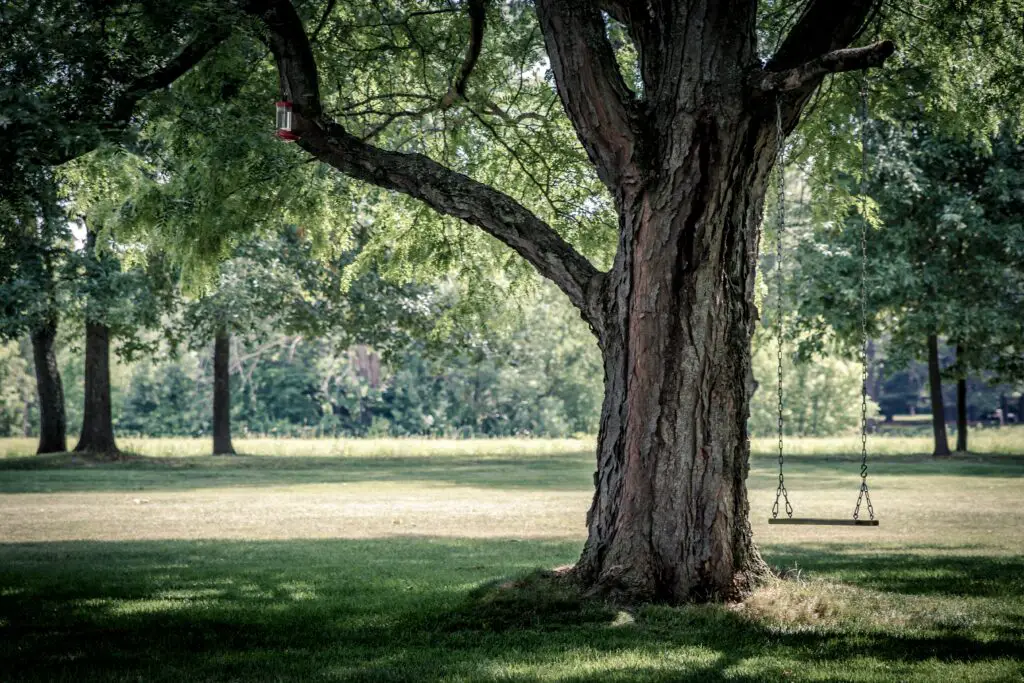How To Hang A Swing From A Tree?
Tree swing can be very fun. Swing can take us back to our childhoods even if we aren’t the riders. It will be more fantastic if we can have a swing in our backyard, as part of backyard activities. You can hang a swing from a tree. But, how to hang a swing from a tree?
Tips On How To Hang A Swing From A Tree
We want our children to see that simple joys are possible. To let our children be happy and carefree, we must step back from them. Tree swings are a joy, but they require thought and care. Here are my tips on how to hang a swing from a tree.

1. Choose the right tree
A straight, healthy, mature, and strong hardwood is the best tree to make a swing from. Some species are more desirable than others, and Maple, oak, and beech are good options. Other species, such as black willow and poplar, are weaker and more brittle than others, like birch and birch.
Healthy trees will not show signs of rot, fungus, cracks, hollows, or wood-boring insects. It will have unspotted green leaves, properly shaped leaves, a balanced distribution of limbs, and minimal dead or broken branches. The hollow sound of decay can be heard when you tap the tree with something solid.
While evaluating the area, check for broken limbs hanging from the branches. To make the site safe, these will need to be removed.
2. Select the right limb
The type of tree swing you are hanging will determine the ideal limb for your swing. The stem of a traditional swing with two ropes must be horizontal, and the stalk does not need to be straight for a single-rope disc swing. A limb should be at least 8 inches in diameter.
It must be in good health. Cracks, holes, fungus, and missing bark are signs of genuine compromise. You should pay particular attention to the union between the trunk and limb for cracks or signs that weak attachment has occurred, such as crowding by other branches. Keep an eye on the tree or limb for any changes after the swing has been hung.
Within reason, higher is better. A swing created by a limb 20 feet above the ground will have a greater arc and better rhythm than one only 10 feet away. This objective must be balanced by the need to work safely, confidently, and within your abilities. Anything in the middle will do just fine. It is possible to hire a tree specialist.
If you notice that a limb is looking good from the ground, then it’s worth inspecting up close.
3. The landing zone is essential
Tree swing should have a landing zone free from hazards and relatively soft. Most natural surfaces provide enough cushion. However, rocks, stumps, and exposed roots can pose risks. It is important to trim any branches intruding on the swing’s travel and clear the landing area.
The sloping ground can pose problems. The swing’s fall height can increase as the grade falls. There is a chance of a rider falling after a fall or dismounting is also growing. It is safer to be level.
The swing should be hung as close to the trunk as possible not to create a collision hazard. The limb is a long, straight lever.
Limb union is more stressed if the swing is placed further away from the trunk. The swing should be 3 to 5 feet away from the box. Two-rope swings are giant pendulums with a straight path. They can be hung closer to the tree at the lower end of their range. Single-rope swings have more movement freedom, so you’ll need to be farther from the trunk.
4. Take into account the height of your rider
How high should the swing be hung? The height of a tree swing will depend on the person using it the most.
When the swing is empty, it sits higher. The swing also sits higher if the rope is fresh when it has not been stretched and tightened.
A good starting point for an unloaded swing is 24 inches, and the target ground clearance under load is approximately half that. From there, adjust. It should be simple to get on and off the swing. When hanging the swing, it is a good idea to have the primary swingers with you. Also, it helps to have someone with you on the ground.
5. Work safely
There are significant risks when working at height. An enormous extension ladder is the best option for reaching tall limbs. This is one of the most dangerous ways to do the job. But that doesn’t necessarily mean you shouldn’t. This route is not for everyone. Be aware of the risks and be extra cautious.
You should ensure that the ladder has at least four contact points and extends several feet beyond the limb you are working on. It should be set at 75 degrees, and this angle is often shown on the ladder’s side. It should be stable.
Sometimes, you can drive stakes (rebar sections) into the ground near the feet. Then, lash the legs to the stakes so that they don’t move. You can also join the ladder’s top to the limb. You must ensure that nothing is above you that could shake you off or knock you down.
Professional tree care workers may use ladders to climb into trees. They are usually sectional ladders chained to the trunk with standoffs between the ladder and chest to allow toe room. Hunters can climb into tree stands with lighter, more affordable versions.
Safety Equipment
Even with a sturdy ladder, it is possible to fall. Consider a safety line and a climbing helmet. Basic fall arrest systems might include a safety rope and a rope grab. The rope grab moves along the string while you climb, but it will stop you from falling if you fall.
The rope grab is attached to the safety harness’s back D ring via a short lanyard. While it won’t be beneficial when climbing ladders, it can help height. It is also easy to turn a sling around the branch of a nearby tree and attach it to the tree. There are many options, and it is worth learning how to use safety equipment.
Throw lines are a great way to insert a rope into trees. The throw line is a long, thin line with a bag attached. The line is placed over the highest point of your work, such as your crotch or limb.
The rope should be tied to the line and then pulled over. Securely tie one end of the string around the tree. The cord must be long enough to reach the anchor point and down to the ground. Please attach it to the anchor point, and you are good to go.
It would be best if you had the basics of climbing skills, and these skills are helpful and fun to acquire. Innovations like foot ascenders allow you to use your legs to zip up the rope, while braking descenders will enable you to glide back to earth. Arborist harnesses have extra strength and are designed to allow you to work comfortably.
6. Test the swing
Test everything once you have hung your swing. It would be best to start slowly but give your swing a thorough workout.
Push the ropes in every direction. Keep your weight down on the swing. Place your back on the swing. Take a look at your knots. Try a test drive. You will be amazed at how your limb reacts.
You may have to move the anchor point closer or choose a different limb if you notice any bowing or shaking. Please ensure that the swing is at the right height from the tree.
Final Thought
By now, you already know how to hang a swing from a tree. But, before your child uses the swing, check the knots for slippage. Ensure the swing is safe before letting them use. While they use the swing, don’t leave them without monitoring.







